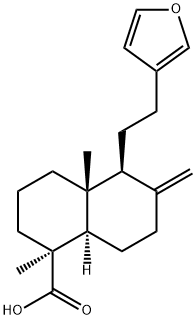| Identification | Back Directory | [Name]
lambertianic acid | [CAS]
4966-13-6 | [Synonyms]
(1S,8aα)-5β-[2-(3-Furyl)ethyl]decahydro-1,4aβ-dimethyl-6-methylene-1-naphthalenecarboxylic acid
1-Naphthalenecarboxylic acid, 5-[2-(3-furanyl)ethyl]decahydro-1,4a-dimethyl-6-methylene-, (1S,4aR,5S,8aR)- | [Molecular Formula]
C20H28O3 | [MDL Number]
MFCD01547650 | [MOL File]
4966-13-6.mol | [Molecular Weight]
316.43 |
| Chemical Properties | Back Directory | [Melting point ]
126-127 °C(Solv: methanol (67-56-1)) | [Boiling point ]
428.6±38.0 °C(Predicted) | [density ]
1.09±0.1 g/cm3(Predicted) | [pka]
4.68±0.60(Predicted) | [LogP]
6.030 (est) |
| Hazard Information | Back Directory | [Description]
Lambertianic acid is a bioactive chemical that is known to have anti-allergic and antibacterial effects. | [Uses]
Lambertianic acid is a bioactive diterpene with anti-allergic, antibacterial and anticancer activities. Lambertianic acid decreases androgen receptor protein levels, cellular and secretory levels of prostate-specific antigen. Lambertianic acid also suppresses cell proliferation by inducing G1 arrest, downregulating CDK4/6 and cyclin D1, activating p53, p21 and p27. Lambertianic acid induces Apoptosis and the expression of related proteins, including cleaved caspase-3/9, c-PARP and BAX, and inhibited BCl-2. Lambertianic acid is promising for research of prostate cancer[1]. | [References]
[1] Lee MS, et al. Anti-Cancer Effect of Lambertianic Acid by Inhibiting the AR in LNCaP Cells. Int J Mol Sci. 2016 Jul 7;17(7):1066. DOI:10.3390/ijms17071066 |
|
|





